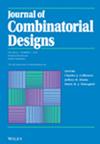下载PDF
{"title":"完成部分k星设计","authors":"Ajani De Vas Gunasekara, Daniel Horsley","doi":"10.1002/jcd.22003","DOIUrl":null,"url":null,"abstract":"<p>A <span></span><math>\n <semantics>\n <mrow>\n \n <mrow>\n <mi>k</mi>\n </mrow>\n </mrow>\n </semantics></math><i>-star</i> is a complete bipartite graph <span></span><math>\n <semantics>\n <mrow>\n \n <mrow>\n <msub>\n <mi>K</mi>\n \n <mrow>\n <mn>1</mn>\n \n <mo>,</mo>\n \n <mi>k</mi>\n </mrow>\n </msub>\n </mrow>\n </mrow>\n </semantics></math>. A <i>partial</i> <span></span><math>\n <semantics>\n <mrow>\n \n <mrow>\n <mi>k</mi>\n </mrow>\n </mrow>\n </semantics></math><i>-star design of order</i> <span></span><math>\n <semantics>\n <mrow>\n \n <mrow>\n <mi>n</mi>\n </mrow>\n </mrow>\n </semantics></math> is a pair <span></span><math>\n <semantics>\n <mrow>\n \n <mrow>\n <mrow>\n <mo>(</mo>\n \n <mrow>\n <mi>V</mi>\n \n <mo>,</mo>\n \n <mi>A</mi>\n </mrow>\n \n <mo>)</mo>\n </mrow>\n </mrow>\n </mrow>\n </semantics></math> where <span></span><math>\n <semantics>\n <mrow>\n \n <mrow>\n <mi>V</mi>\n </mrow>\n </mrow>\n </semantics></math> is a set of <span></span><math>\n <semantics>\n <mrow>\n \n <mrow>\n <mi>n</mi>\n </mrow>\n </mrow>\n </semantics></math> vertices and <span></span><math>\n <semantics>\n <mrow>\n \n <mrow>\n <mi>A</mi>\n </mrow>\n </mrow>\n </semantics></math> is a set of edge-disjoint <span></span><math>\n <semantics>\n <mrow>\n \n <mrow>\n <mi>k</mi>\n </mrow>\n </mrow>\n </semantics></math>-stars whose vertex sets are subsets of <span></span><math>\n <semantics>\n <mrow>\n \n <mrow>\n <mi>V</mi>\n </mrow>\n </mrow>\n </semantics></math>. If each edge of the complete graph with vertex set <span></span><math>\n <semantics>\n <mrow>\n \n <mrow>\n <mi>V</mi>\n </mrow>\n </mrow>\n </semantics></math> is in some star in <span></span><math>\n <semantics>\n <mrow>\n \n <mrow>\n <mi>A</mi>\n </mrow>\n </mrow>\n </semantics></math>, then <span></span><math>\n <semantics>\n <mrow>\n \n <mrow>\n <mrow>\n <mo>(</mo>\n \n <mrow>\n <mi>V</mi>\n \n <mo>,</mo>\n \n <mi>A</mi>\n </mrow>\n \n <mo>)</mo>\n </mrow>\n </mrow>\n </mrow>\n </semantics></math> is a (complete) <span></span><math>\n <semantics>\n <mrow>\n \n <mrow>\n <mi>k</mi>\n </mrow>\n </mrow>\n </semantics></math><i>-star design</i>. We say that <span></span><math>\n <semantics>\n <mrow>\n \n <mrow>\n <mrow>\n <mo>(</mo>\n \n <mrow>\n <mi>V</mi>\n \n <mo>,</mo>\n \n <mi>A</mi>\n </mrow>\n \n <mo>)</mo>\n </mrow>\n </mrow>\n </mrow>\n </semantics></math> is <i>completable</i> if there is a <span></span><math>\n <semantics>\n <mrow>\n \n <mrow>\n <mi>k</mi>\n </mrow>\n </mrow>\n </semantics></math>-star design <span></span><math>\n <semantics>\n <mrow>\n \n <mrow>\n <mrow>\n <mo>(</mo>\n \n <mrow>\n <mi>V</mi>\n \n <mo>,</mo>\n \n <mi>ℬ</mi>\n </mrow>\n \n <mo>)</mo>\n </mrow>\n </mrow>\n </mrow>\n </semantics></math> such that <span></span><math>\n <semantics>\n <mrow>\n \n <mrow>\n <mi>A</mi>\n \n <mo>⊆</mo>\n \n <mi>ℬ</mi>\n </mrow>\n </mrow>\n </semantics></math>. In this paper we determine, for all <span></span><math>\n <semantics>\n <mrow>\n \n <mrow>\n <mi>k</mi>\n </mrow>\n </mrow>\n </semantics></math> and <span></span><math>\n <semantics>\n <mrow>\n \n <mrow>\n <mi>n</mi>\n </mrow>\n </mrow>\n </semantics></math>, the minimum number of stars in an uncompletable partial <span></span><math>\n <semantics>\n <mrow>\n \n <mrow>\n <mi>k</mi>\n </mrow>\n </mrow>\n </semantics></math>-star design of order <span></span><math>\n <semantics>\n <mrow>\n \n <mrow>\n <mi>n</mi>\n </mrow>\n </mrow>\n </semantics></math>.</p>","PeriodicalId":15389,"journal":{"name":"Journal of Combinatorial Designs","volume":"33 12","pages":"446-455"},"PeriodicalIF":0.8000,"publicationDate":"2025-08-17","publicationTypes":"Journal Article","fieldsOfStudy":null,"isOpenAccess":false,"openAccessPdf":"https://onlinelibrary.wiley.com/doi/epdf/10.1002/jcd.22003","citationCount":"0","resultStr":"{\"title\":\"Completing Partial \\n \\n \\n \\n k\\n \\n \\n -Star Designs\",\"authors\":\"Ajani De Vas Gunasekara, Daniel Horsley\",\"doi\":\"10.1002/jcd.22003\",\"DOIUrl\":null,\"url\":null,\"abstract\":\"<p>A <span></span><math>\\n <semantics>\\n <mrow>\\n \\n <mrow>\\n <mi>k</mi>\\n </mrow>\\n </mrow>\\n </semantics></math><i>-star</i> is a complete bipartite graph <span></span><math>\\n <semantics>\\n <mrow>\\n \\n <mrow>\\n <msub>\\n <mi>K</mi>\\n \\n <mrow>\\n <mn>1</mn>\\n \\n <mo>,</mo>\\n \\n <mi>k</mi>\\n </mrow>\\n </msub>\\n </mrow>\\n </mrow>\\n </semantics></math>. A <i>partial</i> <span></span><math>\\n <semantics>\\n <mrow>\\n \\n <mrow>\\n <mi>k</mi>\\n </mrow>\\n </mrow>\\n </semantics></math><i>-star design of order</i> <span></span><math>\\n <semantics>\\n <mrow>\\n \\n <mrow>\\n <mi>n</mi>\\n </mrow>\\n </mrow>\\n </semantics></math> is a pair <span></span><math>\\n <semantics>\\n <mrow>\\n \\n <mrow>\\n <mrow>\\n <mo>(</mo>\\n \\n <mrow>\\n <mi>V</mi>\\n \\n <mo>,</mo>\\n \\n <mi>A</mi>\\n </mrow>\\n \\n <mo>)</mo>\\n </mrow>\\n </mrow>\\n </mrow>\\n </semantics></math> where <span></span><math>\\n <semantics>\\n <mrow>\\n \\n <mrow>\\n <mi>V</mi>\\n </mrow>\\n </mrow>\\n </semantics></math> is a set of <span></span><math>\\n <semantics>\\n <mrow>\\n \\n <mrow>\\n <mi>n</mi>\\n </mrow>\\n </mrow>\\n </semantics></math> vertices and <span></span><math>\\n <semantics>\\n <mrow>\\n \\n <mrow>\\n <mi>A</mi>\\n </mrow>\\n </mrow>\\n </semantics></math> is a set of edge-disjoint <span></span><math>\\n <semantics>\\n <mrow>\\n \\n <mrow>\\n <mi>k</mi>\\n </mrow>\\n </mrow>\\n </semantics></math>-stars whose vertex sets are subsets of <span></span><math>\\n <semantics>\\n <mrow>\\n \\n <mrow>\\n <mi>V</mi>\\n </mrow>\\n </mrow>\\n </semantics></math>. If each edge of the complete graph with vertex set <span></span><math>\\n <semantics>\\n <mrow>\\n \\n <mrow>\\n <mi>V</mi>\\n </mrow>\\n </mrow>\\n </semantics></math> is in some star in <span></span><math>\\n <semantics>\\n <mrow>\\n \\n <mrow>\\n <mi>A</mi>\\n </mrow>\\n </mrow>\\n </semantics></math>, then <span></span><math>\\n <semantics>\\n <mrow>\\n \\n <mrow>\\n <mrow>\\n <mo>(</mo>\\n \\n <mrow>\\n <mi>V</mi>\\n \\n <mo>,</mo>\\n \\n <mi>A</mi>\\n </mrow>\\n \\n <mo>)</mo>\\n </mrow>\\n </mrow>\\n </mrow>\\n </semantics></math> is a (complete) <span></span><math>\\n <semantics>\\n <mrow>\\n \\n <mrow>\\n <mi>k</mi>\\n </mrow>\\n </mrow>\\n </semantics></math><i>-star design</i>. We say that <span></span><math>\\n <semantics>\\n <mrow>\\n \\n <mrow>\\n <mrow>\\n <mo>(</mo>\\n \\n <mrow>\\n <mi>V</mi>\\n \\n <mo>,</mo>\\n \\n <mi>A</mi>\\n </mrow>\\n \\n <mo>)</mo>\\n </mrow>\\n </mrow>\\n </mrow>\\n </semantics></math> is <i>completable</i> if there is a <span></span><math>\\n <semantics>\\n <mrow>\\n \\n <mrow>\\n <mi>k</mi>\\n </mrow>\\n </mrow>\\n </semantics></math>-star design <span></span><math>\\n <semantics>\\n <mrow>\\n \\n <mrow>\\n <mrow>\\n <mo>(</mo>\\n \\n <mrow>\\n <mi>V</mi>\\n \\n <mo>,</mo>\\n \\n <mi>ℬ</mi>\\n </mrow>\\n \\n <mo>)</mo>\\n </mrow>\\n </mrow>\\n </mrow>\\n </semantics></math> such that <span></span><math>\\n <semantics>\\n <mrow>\\n \\n <mrow>\\n <mi>A</mi>\\n \\n <mo>⊆</mo>\\n \\n <mi>ℬ</mi>\\n </mrow>\\n </mrow>\\n </semantics></math>. In this paper we determine, for all <span></span><math>\\n <semantics>\\n <mrow>\\n \\n <mrow>\\n <mi>k</mi>\\n </mrow>\\n </mrow>\\n </semantics></math> and <span></span><math>\\n <semantics>\\n <mrow>\\n \\n <mrow>\\n <mi>n</mi>\\n </mrow>\\n </mrow>\\n </semantics></math>, the minimum number of stars in an uncompletable partial <span></span><math>\\n <semantics>\\n <mrow>\\n \\n <mrow>\\n <mi>k</mi>\\n </mrow>\\n </mrow>\\n </semantics></math>-star design of order <span></span><math>\\n <semantics>\\n <mrow>\\n \\n <mrow>\\n <mi>n</mi>\\n </mrow>\\n </mrow>\\n </semantics></math>.</p>\",\"PeriodicalId\":15389,\"journal\":{\"name\":\"Journal of Combinatorial Designs\",\"volume\":\"33 12\",\"pages\":\"446-455\"},\"PeriodicalIF\":0.8000,\"publicationDate\":\"2025-08-17\",\"publicationTypes\":\"Journal Article\",\"fieldsOfStudy\":null,\"isOpenAccess\":false,\"openAccessPdf\":\"https://onlinelibrary.wiley.com/doi/epdf/10.1002/jcd.22003\",\"citationCount\":\"0\",\"resultStr\":null,\"platform\":\"Semanticscholar\",\"paperid\":null,\"PeriodicalName\":\"Journal of Combinatorial Designs\",\"FirstCategoryId\":\"100\",\"ListUrlMain\":\"https://onlinelibrary.wiley.com/doi/10.1002/jcd.22003\",\"RegionNum\":4,\"RegionCategory\":\"数学\",\"ArticlePicture\":[],\"TitleCN\":null,\"AbstractTextCN\":null,\"PMCID\":null,\"EPubDate\":\"\",\"PubModel\":\"\",\"JCR\":\"Q3\",\"JCRName\":\"MATHEMATICS\",\"Score\":null,\"Total\":0}","platform":"Semanticscholar","paperid":null,"PeriodicalName":"Journal of Combinatorial Designs","FirstCategoryId":"100","ListUrlMain":"https://onlinelibrary.wiley.com/doi/10.1002/jcd.22003","RegionNum":4,"RegionCategory":"数学","ArticlePicture":[],"TitleCN":null,"AbstractTextCN":null,"PMCID":null,"EPubDate":"","PubModel":"","JCR":"Q3","JCRName":"MATHEMATICS","Score":null,"Total":0}
引用次数: 0
引用
批量引用


 求助内容:
求助内容: 应助结果提醒方式:
应助结果提醒方式:


